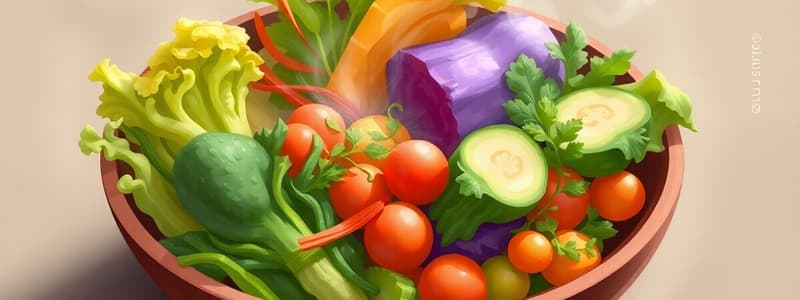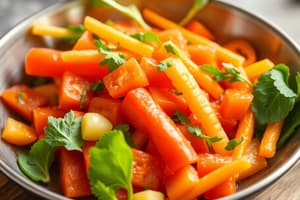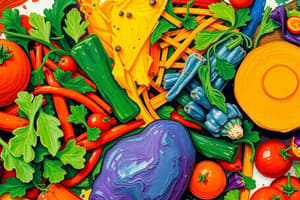Podcast
Questions and Answers
Which method of cooking vegetables retains nutrients and phytochemicals while being a source of calories?
Which method of cooking vegetables retains nutrients and phytochemicals while being a source of calories?
- Boiling
- Steaming
- Oven Roasting
- Stir-frying (correct)
What can be done to enhance the flavor of steamed vegetables?
What can be done to enhance the flavor of steamed vegetables?
- Adding a small amount of honey or maple syrup
- Adding a small amount of sugar
- Adding a small amount of salt
- Adding a small amount of soy sauce or citrus (correct)
Which of the following vegetables are mentioned as having enhanced flavour when oven roasted?
Which of the following vegetables are mentioned as having enhanced flavour when oven roasted?
- Onions, parsnips, winter squash, eggplant, sweet potatoes and onions (correct)
- Broccoli, carrots, and zucchini
- Tomatoes, peppers, and cucumbers
- Cauliflower, asparagus, and mushrooms
Which cooking method mentioned in the text preserves nutrients but involves longer cooking times?
Which cooking method mentioned in the text preserves nutrients but involves longer cooking times?
What is the primary recommendation for cooking vegetables based on the text?
What is the primary recommendation for cooking vegetables based on the text?
What is the primary reason why boiling vegetables can lead to a significant loss of nutrients?
What is the primary reason why boiling vegetables can lead to a significant loss of nutrients?
Which of these vitamins is particularly vulnerable to loss during boiling?
Which of these vitamins is particularly vulnerable to loss during boiling?
What is the ideal amount of water to use when cooking vegetables in a microwave?
What is the ideal amount of water to use when cooking vegetables in a microwave?
How does steaming compare to boiling in terms of folate retention?
How does steaming compare to boiling in terms of folate retention?
Which of the following vegetables are considered cruciferous vegetables?
Which of the following vegetables are considered cruciferous vegetables?
What is the recommended cooking time for steaming spinach to minimize folate loss?
What is the recommended cooking time for steaming spinach to minimize folate loss?
Why is stir-frying considered a good method for preserving nutrients in vegetables?
Why is stir-frying considered a good method for preserving nutrients in vegetables?
Flashcards
Nutritional value of veggies
Nutritional value of veggies
The health benefits, vitamins, and phytochemicals contained in vegetables.
Impact of boiling
Impact of boiling
Boiling can lead to significant loss of water-soluble vitamins and antioxidants.
Steaming vs. boiling
Steaming vs. boiling
Steaming vegetables preserves more vitamins and antioxidants than boiling them.
Water-soluble vitamins
Water-soluble vitamins
Signup and view all the flashcards
Microwaving technique
Microwaving technique
Signup and view all the flashcards
Phytochemicals
Phytochemicals
Signup and view all the flashcards
Cooking time and temperature
Cooking time and temperature
Signup and view all the flashcards
Cruciferous vegetables
Cruciferous vegetables
Signup and view all the flashcards
Stir-frying
Stir-frying
Signup and view all the flashcards
Nutrient retention
Nutrient retention
Signup and view all the flashcards
Oven roasting
Oven roasting
Signup and view all the flashcards
Minimal cooking water
Minimal cooking water
Signup and view all the flashcards
Steaming vegetables
Steaming vegetables
Signup and view all the flashcards
Study Notes
Maximizing Veggie Nutrition
- Consuming more vegetables lowers cancer risk and improves health. Proper preparation is key to retaining nutrients.
- Excessive heat and water can diminish vitamins, minerals, and phytochemicals (healthful plant compounds).
Minimizing Nutrient Loss
- Boiling: Traditional boiling in large amounts of water leads to significant loss of water-soluble vitamins (like vitamin C and folate) and certain antioxidant phytochemicals.
- Steaming: Steaming is a better method, causing minimal or no loss of folate and preserving more antioxidants, compared to boiling. Studies show significant retention of nutrients in steamed broccoli and spinach.
- Microwave Cooking: Minimizing water is crucial. Using minimal water helps preserve nutrients. Rapid cooking times, like microwave cooking, minimize the loss of heat-sensitive vitamins (C, B complex). But if too much water is used, significant loss of antioxidants occurs.
- Stir-frying: Use minimal oil to avoid excess calories. Rapid cooking due to smaller pieces of vegetables minimizes loss of heat-sensitive nutrients.
- Oven Roasting: Higher temperatures and prolonged cooking times may lead to some nutrient loss compared to other methods. Some vegetables may have enhanced flavors through this process.
Specific Vegetable Examples
- Cruciferous vegetables (broccoli, Brussels sprouts, cabbage): Boiling causes significant loss of glucosinolates (antioxidants). Steaming, microwaving, and stir-frying cause little to no loss.
- Spinach and broccoli: Steaming retains more folate than boiling.
- Zucchini, beans, carrots: Cooking with minimal water leads to higher flavonoid (phytochemicals) levels.
Flavor Enhancement
- Adding flavors to steaming water (soy sauce, citrus) or to the finished product (honey, maple syrup) can enhance the taste of vegetables without compromising nutrients.
Studying That Suits You
Use AI to generate personalized quizzes and flashcards to suit your learning preferences.




